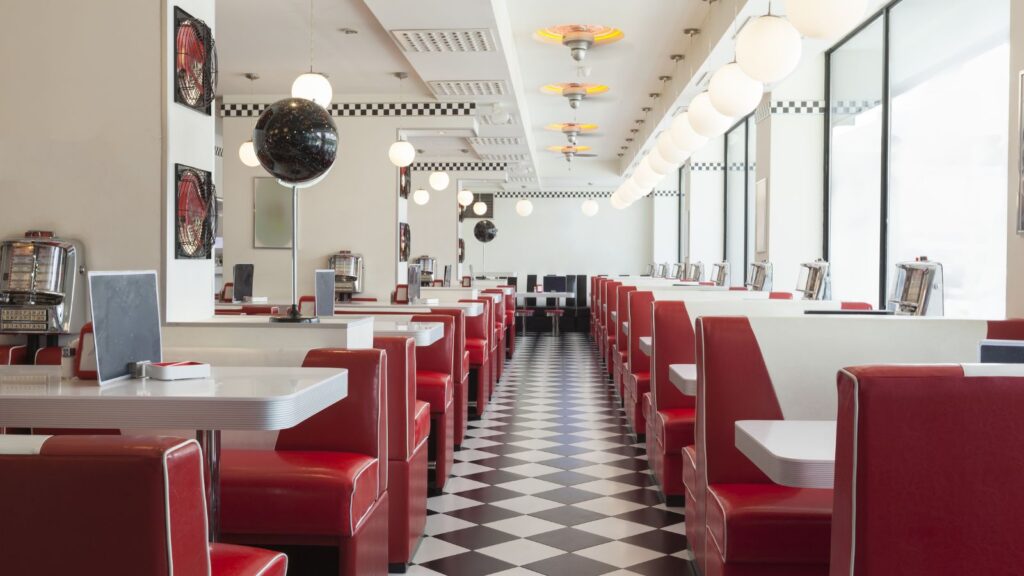Traditions come and go as technologies are replaced and American society changes. These 19 traditions have been declining in recent decades, and many could completely disappear in the near future.
Black Friday Shopping in Stores

Black Friday sales have gripped Americans for decades, but their appeal has diminished in recent years as online shopping with year-round sales has become more popular. Craig Johnson, the founder of Customer Growth Partners, told the New York Times that “it’s still a cultural event” but “nothing like it used to be.”
Drive-in Theaters

During their peak in the late 1950s, there were over 4,000 drive-in theaters, mostly in rural areas across America. Today, fewer than 200 remain, as they’ve become less economically viable for owners who prefer to sell their land to developers, and home entertainment has become the norm.
Door-to-Door Salesmanship

Door-to-door salesmen have become increasingly rare over the past couple of decades. The internet has allowed sales professionals to use more varied channels to reach potential customers, including emails, web chats, and social media.
Printed Phone Books

Printed phone books were useful tools for Americans to find and contact local businesses. The internet rendered them obsolete, and concerns were raised over their environmental impact. The Yellow Pages moved online in 2019, but most Americans use a Google search instead.
Manual Car Transmissions

Nearly all cars sold in America are automatic, and most car makers have stopped producing vehicles with manual transmissions. Most Europeans still learn to drive manual cars, which Americans view as less practical.
Coal Mining Towns

The coal industry in America has greatly declined over the past few decades as environmental regulations and renewables have become cheaper to produce. Once prosperous mining towns like Thurmond, West Virginia, became depopulated, mines shut down, and locals moved to find new work.
Physical Newspapers

Sales of physical newspapers have been declining in America since the 1990s. Americans now get most of their news online, which offers instant breaking updates. Press Gazette reports that the “pandemic increased the rate of decline” and that the largest print titles fell 14% in the year to March 2023.
Factory Jobs

The number of Americans employed in factories has decreased in recent years as production has been outsourced to countries across the world with lower labor costs, and automation has replaced manual labor positions. Despite the Biden administration’s push to increase the number of factory jobs in the electric vehicle, green technology, and semiconductor industries, they’re continuing to decline overall.
In-Person Voting

Mail-in voting rates have increased since the pandemic, despite a dip in the 2022 midterm elections. In-person voting is likely to remain popular in the coming years, and some states have passed laws trying to restrict mail-in voting, but the trend is toward not physically attending the poll booth.
Cable TV

Cable TV has become less popular over the past decade as Americans have switched to streaming services. Investopedia argues that it’s experiencing a slow death as streaming services have become more popular, consumers have become less willing to pay for channels they don’t watch, the cost of bundled cable subscriptions has grown, and Americans now prefer the convenience of switching between devices.
Diner Culture

Diners have permeated American culture over the past century, but the pandemic damaged the industry and worsened the shortage of qualified workers. Diners are finding ways to respond to the dip in the number of qualified workers and Americans eating out, including by removing tipping and adding a mandatory service fee, but the industry is struggling.
Mail-in Rebates

Mail-in rebates offer a partial or full refund in exchange for proof that a customer bought the item, but many are never redeemed and have deliberately confusing instructions. ModernRetail argues that they’re “quickly becoming a thing of the past as retailers increasingly adopt app-based reimbursement promotions using platforms like Venmo.”
Landline Telephones

Landline telephones were essential for communication for decades in America, but the ubiquity of mobile phones today makes them increasingly obsolete. Companies are also phasing them out in favor of VoIP and mobile networks.
Public Pay Phones

Cities and towns nationwide used to be filled with public pay phones, but they’ve become obsolete as mobile phone ownership has become universal. Their maintenance costs have long outweighed their usage and revenue, and most have been removed across American cities.
Local Video Rental Stores

The rise of VHS in the 1980s saw local video rental stores pop up nationwide, and Blockbuster became a powerhouse in the industry. The dominance of streaming services and digital rental options over the past decade has decimated video rental stores, and today only one Blockbuster remains open.
College Textbooks

Buying expensive textbooks has long been a part of the college experience in America, but sales have decreased over the past decade. Concerns over the cost of textbooks are driving students and faculty to cheaper digital alternatives.
Checks for Payments

Paper checks have been a popular form of payment for decades in America, but their use has rapidly declined over the past two decades as mobile banking apps and digital payments have replaced them. The Washington Post reports that “most Americans (57 percent in 2020 and 2021) have not written a check in the last month.”
Greeting Cards

Sales of the greeting card industry have dwindled in recent years, and retailers have scaled back their shelf space. The rise of instant messaging on social media has seen the industry shift to e-cards, but some younger Americans still value physical greeting cards.
Traditional Pensions

Millions of Americans used to work for one company for 30 years before retiring with a defined-benefit plan or pension. However, these plans have since been replaced by less expensive and complex defined-contribution plans like the 401(k) in the private sector.
Up Next: 18 Cities in the US That Are So Bad You Won’t Want to Visit

While there are many beautiful cities in the U.S. that are well worth a visit, there are also some that you may want to avoid. This is largely due to high crime rates or issues with quality of life. Here are 18 U.S. cities that you won’t want to visit.
18 Cities in the US That Are So Bad You Won’t Want to Visit
19 American Cities That Disappoint Visitors So Much They Wish They Never Went

The United States is a vast country with over 109,000 cities and towns and many popular tourist hotspots, promising visitors fascinating history, famous landmarks, natural wonders, impressive architecture, and cultural delights. But not every city lives up to the hype! Here, we explore 19 American destinations that often leave visitors underwhelmed.
19 American Cities That Disappoint Visitors So Much They Wish They Never Went
19 Signs That Say You’ve Officially Entered Old Age

Old age comes for us all, though we do our best to resist it for as long as possible. But aging isn’t only gray hair, wrinkled skin, and yelling at kids to get off your lawn. Here are 19 signs you’ve realized you’re no longer the young stud you once were!

